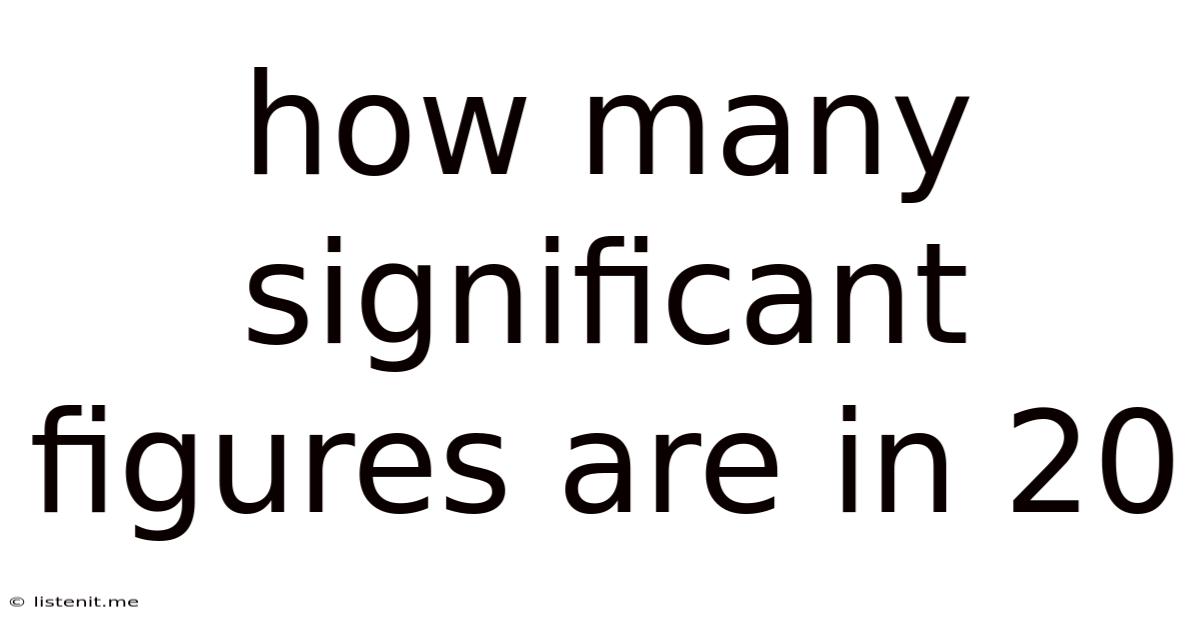How Many Significant Figures Are In 20
listenit
May 09, 2025 · 4 min read

Table of Contents
How Many Significant Figures Are in 20? A Deep Dive into Significant Figures
The seemingly simple question, "How many significant figures are in 20?" actually opens a door to a deeper understanding of significant figures (sig figs), a crucial concept in scientific notation and accurate data representation. The answer isn't as straightforward as it might initially appear, and depends heavily on the context of the number 20. This article will explore the nuances of significant figures, focusing specifically on the ambiguity surrounding the number 20 and providing a comprehensive guide to determining significant figures in various scenarios.
Understanding Significant Figures
Significant figures are the digits in a number that carry meaning contributing to its precision. They represent the level of accuracy in a measurement or calculation. Zeroes play a particularly tricky role in determining significant figures. To understand the significance of 20, let's review the general rules:
Rules for Determining Significant Figures:
-
Non-zero digits are always significant. The digits 1 through 9 are always significant.
-
Zeros between non-zero digits are always significant. For example, in 1001, all four digits are significant.
-
Leading zeros are never significant. Leading zeros are those that appear before the first non-zero digit. For example, in 0.0025, only the 2 and 5 are significant.
-
Trailing zeros are significant only if the number contains a decimal point. In the number 20, this is where the ambiguity arises. If the number is written as 20., then both digits are significant. If it's simply 20, the significance of the trailing zero is debatable and requires further context.
-
Trailing zeros in a number without a decimal point are ambiguous. This is the heart of the issue regarding the number 20. Is it a precise measurement to the nearest ones, or is it a rounded-off value from a larger range, like 16-24? This uncertainty makes the number of significant figures unclear.
The Ambiguity of 20: Scenarios and Interpretations
The number 20 can represent varying levels of precision. Its ambiguity stems from the trailing zero's uncertain significance. To understand this, consider the following scenarios:
Scenario 1: Exact Count
If 20 represents an exact count, like 20 apples, then both digits are considered significant. In this case, the precision is implicitly absolute. There are precisely twenty apples; no rounding or estimation is involved.
Scenario 2: Measurement with Limited Precision
Imagine measuring the length of an object. If the measuring instrument only measures to the nearest unit, and the reading is 20 units, then there is only one significant figure. The trailing zero is merely a placeholder indicating the order of magnitude and doesn't necessarily reflect precision beyond the ones place.
Scenario 3: Rounded Measurement
If 20 is a rounded number, say from a measurement of 20.3, then it can have either one or two significant figures, depending on how the rounding was performed. If rounded to the nearest ten, only one significant figure is present. However, if rounded to the nearest one, then it can be considered as having two significant figures.
Scenario 4: Scientific Notation
Using scientific notation resolves the ambiguity. If the number 20 is expressed as 2.0 x 10¹, then it clearly indicates two significant figures. The inclusion of the decimal point explicitly makes the trailing zero significant. Similarly, 2.00 x 10¹ would represent three significant figures.
Best Practices for Clarity
To avoid ambiguity when dealing with trailing zeros, the best practice is to use scientific notation or explicitly include the decimal point to clarify the number of significant figures. This eliminates any uncertainty and ensures clear communication of the accuracy of the measurement or calculation.
For instance:
-
One significant figure: 2 x 10¹ or 20 (clearly indicating rounding to the nearest ten)
-
Two significant figures: 2.0 x 10¹ or 20. (clearly indicating precision to the nearest one)
The Importance of Significant Figures in Calculations
The correct use of significant figures is crucial for maintaining accuracy in scientific and engineering calculations. Incorrect handling of significant figures can lead to a propagation of error, rendering results unreliable and potentially misleading.
When performing calculations involving significant figures, follow these rules:
-
Addition and Subtraction: The result should have the same number of decimal places as the measurement with the fewest decimal places.
-
Multiplication and Division: The result should have the same number of significant figures as the measurement with the fewest significant figures.
-
Rounding: When rounding, consider the digit following the last significant figure. If this digit is 5 or greater, round up. If it is less than 5, round down.
Conclusion: Context is King
Determining the number of significant figures in 20 highlights the importance of understanding context. Without further information about how the number 20 was obtained, the number of significant figures remains ambiguous. By consistently using scientific notation or explicitly indicating the decimal point, scientists and engineers can communicate their data accurately, avoiding potential errors resulting from ambiguous representations of numbers. Mastering significant figures is essential for anyone working with numerical data, ensuring accuracy and reliability in calculations and results. The seeming simplicity of “20” belies a fundamental principle in data analysis: precision in communication is paramount.
Latest Posts
Latest Posts
-
Lim As X Approaches 0 From The Right
May 09, 2025
-
A Block Of Aluminum Occupies A Volume Of 15 0
May 09, 2025
-
6x 3y 12 In Slope Intercept Form
May 09, 2025
-
5 X 10 To The Power Of 4
May 09, 2025
-
Do Diastereomers Have Different Chemical Properties
May 09, 2025
Related Post
Thank you for visiting our website which covers about How Many Significant Figures Are In 20 . We hope the information provided has been useful to you. Feel free to contact us if you have any questions or need further assistance. See you next time and don't miss to bookmark.